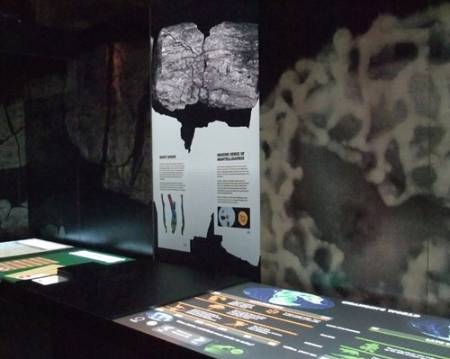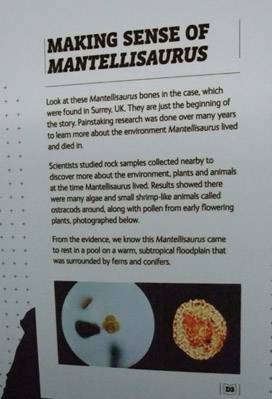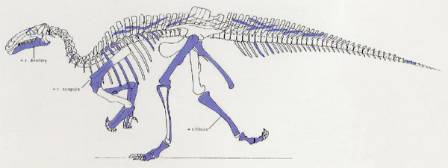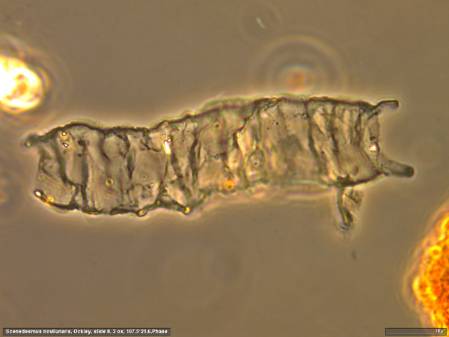The permanent Dinosaur gallery at the Museum is open every day of the year (except 24 to 26 December) but the recent temporary exhibition 'Age of the Dinosaur' closed last week and now sets off on its travels to another temporary location. Keen eyed visitors to Age of the Dinosaur may have seen some microfossil pictures lurking at the back of the exhibit. Microfossils and dinosaurs are at different ends of the size scale so how can work on microfossils be related to dinosaur research?
The display in the 'Age of the Dinosaur' exhibit including the microfossil images
A neat piece of work published in 2008 by several former colleagues in the Journal Cretaceous Research described some ostracods, spores and pollen from a dinosaur excavation site at Ockley in Surrey. These microfossils show that an Iguanodon died and was buried in a temporary freshwater pond, while the spores and pollen indicate that the Iguanodon lived in a world dominated by certain types of ferns and conifers. The microfossil assemblage tells us that the Iguanodon died in the early part of the Barremian, a stage of the Cretaceous 121-127 million years ago.
Dinosaur officionados will correct me and say that Iguanodon is now called Mantellisaurus. Details about dinosaurs can be found on the Museum web site if you are interested to read further.
In 2001 a large party from the Department of Palaeontology spent two weeks excavating a site at Ockley where the partial skeleton of an Iguanodon had been found by a members of a Geologists' Association field excursion. News of the find had spread very quickly to the popular press so we had to take it in turns to stay overnight in a tent at the site so that we could make sure that is wasn't ravaged by opportunist collectors.
The parts of the Ockley Iguanodon skeleton that were recovered in the excavation.
I remember being asked to wield a pick axe and shovel so that we could clear the overlying rock from the rock bed that the fossil bones had been found in. Meanwhile my vertebrate colleagues were on their hands and knees preparing away the bones that had become exposed on the surface. These were then taken back to the museum still encased in the rock so that they could be further prepared by David Gray in the Palaeontology Conservation Unit.
My former colleague Susanne Feist-Burhardt collected samples for microfossil study from the dinosaur bed and the beds above and below. These were studied for palynology by MSc student Elly Nye and by David Horne and John Whittaker for ostracod microfossils.
Examples of some of the spores and pollen obtained from the dinosaur site. The palynological record suggests that the dinosaur came to rest on a warm subtropical flood plain surrounded by ferns and conifers.
The freshwater green algae Scenedesmus novilunaris found in the dinosaur bed suggests that its final resting place was a freshwater pond.
The ostracod Cypridea clavata along with other evidence suggests that the pond dried out periodically.
Samples close to the dinosaur bed produced the first recognisable ostracods from the Ockley site allowing a firm date of the age of the sediments to be established. The single species of the genus Cypridea found suggests that the pond dried out on a regular basis. The eggs that this group of ostracods produces are resistant to dry periods. As a result, their relatives are often found in modern day temporary ponds. More common Cretaceous ostracods that require permanent water bodies are absent from the Ockley assemblage giving further evidence for the temporary nature of the pond where the Iguanodon came to rest.
This was a very interesting project to play a small part in and shows the power of tackling projects as a group. It also shows some excellent potential applications of micropalaeontology so I was very glad that it became part of the 'Age of the Dinosaur' exhibit.








